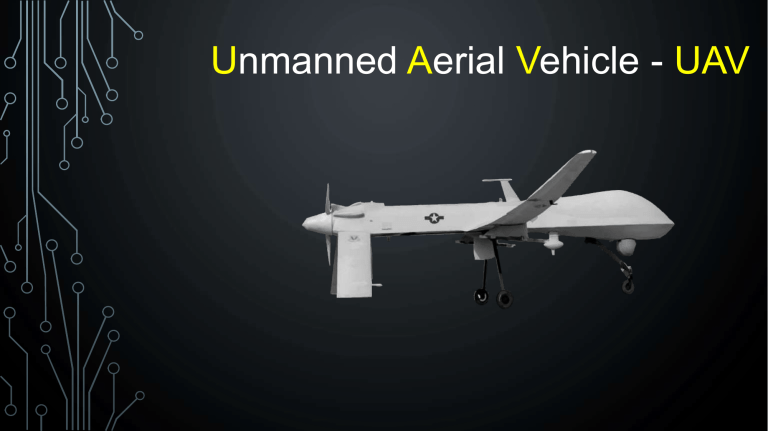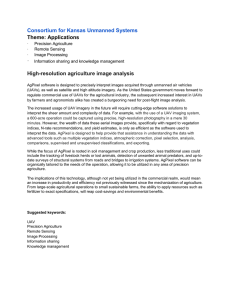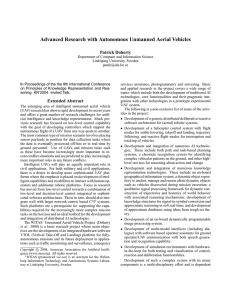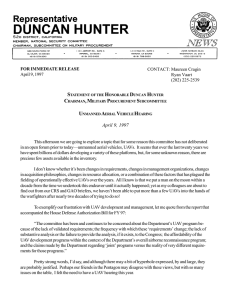
Unmanned Aerial Vehicle - UAV CONTENTS • Introduction • UAV's disadvantages • Brief History of UAVs • Sub-System of UAV • Design Parameters • Applications of UAV - Disaster relief - Search and rescue - Sports - Armed Attacks TERMS UAV – Unmanned Aerial Vehicle Drone – Unmanned robotic probe – air, land, sea UCAV – Unmanned Combat Aerial Vehicle INTRODUCTION • Drones are also referred as UAV: Unmanned Aerial Vehicle • It is an aircraft without an onboard pilot, so the name is ‘UNMANNED’ aerial vehicle • Its flight is either pre-defined or controlled autonomously by computers or under the remote control of a pilot on the ground. BRIEF HISTORY OF UAV • In 1916, Archibald Montgomery Low’s “Aerial Target” was one of the first unmanned aerial vehicle BRIEF HISTORY OF UAV • Using UAV for military purpose began in 1959, when United States Air Force concerned about losing pilots over hostile territory and they began to think unmanned flights. BRIEF HISTORY OF UAV • In the year of1964, U.S Navy initiated America’s highly classified ‘Red Wagon’ UAVs in their first combat reconnaissance missions in the Vietnam war. SUB-SYSTEM OF UAV • UAV is a system consisting of different subsystems • Unmanned aircraft (UA) • Control system, such as Ground Control Station (GCS) • Control link • Other related support equipment. DESIGN PARAMETERS • Aerodynamics • Payload • Endurance • Speed and range • Communications • Navigation system • Launch and recovery CLASSIFICATION OF UAVS UAVs are typically fallen into five functional categories: • Target and decoy – providing ground and aerial gunnery a target that simulates an enemy aircraft or missile • Reconnaissance – providing battlefield intelligence • Combat – providing attack capability for high-risk missions • Logistics – specifically designed for cargo and logistics operation • Civil and Commercial UAVs – specifically designed for civil and commercial applications APPLICATIONS OF UAV • There are many different applications of UAVs. Some of the applications of UAVs are listed below, - Search and rescue - Disaster relief - Sports - Commercial aerial surveillance - Commercial and motion picture filmmaking - Armed attacks DISASTER RELIEF • UAVs transport medicines and vaccines, and retrieve medical samples, into and out of remote or other inaccessible regions • UAVs can help in disaster relief by gathering information from across an affected area SEARCH AND RESCUE • During the 2008 hurricanes that struck Louisiana and Texas, Micro UAVs, such as the ‘Aeryon Scout’, have been used to perform search for missing persons. • ‘Predators, operating up to 29.000 feet above sea level, performed search and rescue and damage assessment. SPORTS • Drones were used in the 2014 Winter Olympics in Sochi for filming skiing and snowboarding events • Some advantages of using unmanned aerial vehicles in sports are that they allow cameras to get closer to the athletes. They are more flexible than cable-suspended camera systems. ARMED ATTACKS • Armed ‘Predators’ were first used in late 2001 from bases in Pakistan and Uzbekistan, mostly aimed at assassinating high profile individuals (terrorist leaders, etc.) inside Afghanistan • A Predator based in a neighboring Arab country was used to kill suspected Al-Qaeda terrorists in Yemen on November 3, 2002. This marked the first use of an armed Predator as an attack aircraft outside of a theater of war such as Afghanistan. UAV'S DISADVANTAGES • Innocent Civilian casualties due to inefficiency in recognizing targets • UAV system can be hacked • If connection with the ground station is lost, the vehicle may never return THANK YOU FOR LISTENING



